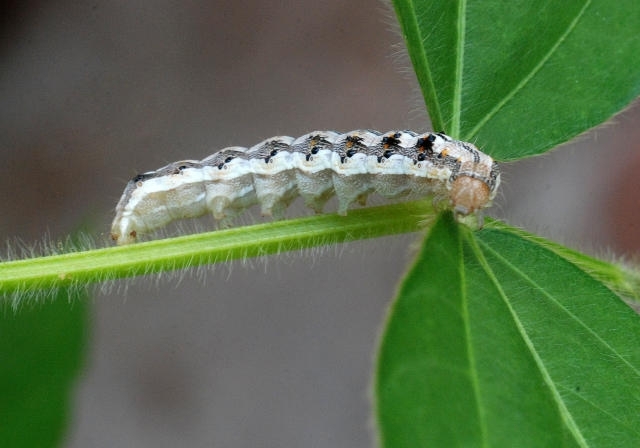


In a search for more sustainable alternatives for agriculture, researchers at UNESP are developing systems to encapsulate synthetic pesticides as well as compounds of botanical, fungal, and bacterial origin; results were presented at FAPESP Week France (photo: caterpillar of species Helicoverpa armigera / Sebastião Araújo / EMBRAPA)
Published on 05/04/2021
By Maria Fernanda Ziegler, from Paris | Agência FAPESP – Brazil is one of the world’s agricultural superpowers and is also a leader in the use of agrotoxins. On one hand, pesticides enable pests to be controlled and an increase in productivity, but on the other, they contaminate water, soil, and food, indirectly affecting human health.
In a search for more sustainable alternatives, researchers at São Paulo State University (UNESP) at Sorocaba, Brazil have been focusing on a combination of nanotechnology and natural products. The topic was addressed by Leonardo Fraceto, coordinator of the Environmental Nanotechnology Laboratory at UNESP, in a lecture given at FAPESP Week France.
“There’s a growing demand for food all over the world and nanotechnology enables the creation of methodologies for increasing agricultural production. I’m not talking about an increase in cultivated area but rather about productive efficiency,” said Fraceto.
As the researcher explained, the aim of the group is to study different systems for encapsulating pest control agents, such as synthetic agrotoxins or insecticides and repellents of botanical origin. “Another line of research proposes the use of biological agents, such as fungi and bacteria, encapsulated in microparticles,” said the researcher.
Within the scope of a Thematic Project supported by FAPESP, the group at UNESP is studying the action mechanisms and toxicity of the methodologies developed.
According to Fraceto, the use of nanoparticles enables the active compound to be delivered directly to where the pest that needs to be fought is, reducing the quantity of pesticide applied to the crop, the toxicity for the plant, and, consequently, the environmental contamination. “The pest, on the other hand, receives a more concentrated load of the agent, which enables a reduction in the number of applications,” he said.
The group has developed, for example, a system for encapsulating atrazine, one of the most widely-sold herbicides in Brazil and already banned in the European Union because of its high toxicity.
“In the laboratory tests, the polymeric nanoparticle formulation was more efficient for controlling pests than the conventional one. We managed to reduce the dosage needed from 3 kilos to 300 grams per hectare. Our next step will be to evaluate the formulation in field studies,” said the researcher.
In another study, published in the journal Pest Management Science, the scientists mixed three different botanical compounds – geraniol (found in geranium, in lemon, and in lemongrass, for example), eugenol (present in clove oil), and cinnamaldehyde (from cinnamon oil) – in polymeric nanocapsules made of zein, a corn protein.
“We’re a multidisciplinary team and are seeking satisfactory solutions from both an ecological and economic viewpoint. We’re cataloguing a number of substances we deem to be interesting for managing pests such as the Helicoverpa caterpillar [soy pest], the armyworm caterpillar, and the red spider mite, for example,” he said.
The FAPESP Week France symposium was held between November 21st and 27th, thanks to a partnership between FAPESP and the universities of Lyon and Paris, both in France. Read other news about the event at http://www.fapesp.br/week2019/france/.
Source: https://agencia.fapesp.br/32079